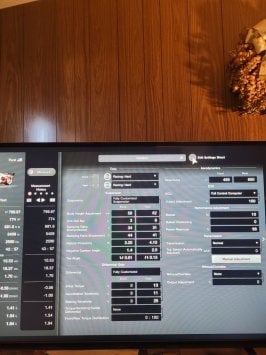After reading your post. I decided to try out what you stated. I am not a tuner by no means. Actually I get my tunes from this forum. So to get to the point I looked at the most stable car that I have which is the Road Version Tomahawk. I looked at the values that were listed for stability which are Low Speed -0.74, High Speed -1.0. I then took a GR.3 C7 and determine the base tune and saved it. Then I created a new tune and adjusted things until I had as close to the same stability numbers for low and high speed as possible. The values I changed on the C7 were height, rear roll bar, negative camber, toe angle, LSD Initial and Braking. The final numbers on the C7 are -0.67 low speed and -1.0 High speed. I then tested both setups on a time trial at spa-francorchamps. The average time decrease between the base and the tuned was 4 seconds. I know it wasn’t a perfect test, but I can say that you guys are defiantly going in the right direction.
Ah, I made the same mistake at first but you don't actually want to be trying to get cars to the same Stability values. If they happen to work by coincidence that's fine, but the 'right' Stability for each car is determined more by stuff like power, weight balance, driven wheels etc.
Power and driven wheels are maybe the most important stats to keep in mind, while you apply throttle you are changing the Stability of the car. If you apply throttle with a RWD car, you are moving the Stability values closer to +1.00, and while you apply throttle with a FWD car you are moving them closer to -1.00.
If I have an 800bhp RWD car I am going to want Stability settings that are strongly biased towards understeer at high speed, because the moment I try and apply full throttle mid corner, the Stability of the car is going to drastically change. But if my car only has 200bhp I don't have to worry about it as much, I still want understeer bias but because it has less power the Stability won't be affected as much, so I will probably be faster with a car that has less understeer bias.
Always remember as well that the Stability numbers only go up to 1.00 on paper, but they can actually be much much larger than this. This is another reason not to try and match Stability numbers, once you get to 1.00 it's impossible to know what the number actually is, it could be 1.01 or it could be 3.00.
This stuff applies to brake balance too: If your car has understeer bias you probably want to move brake bias towards the rear. If the car has oversteer bias you want to move the balance forwards to make braking into corners more stable.


